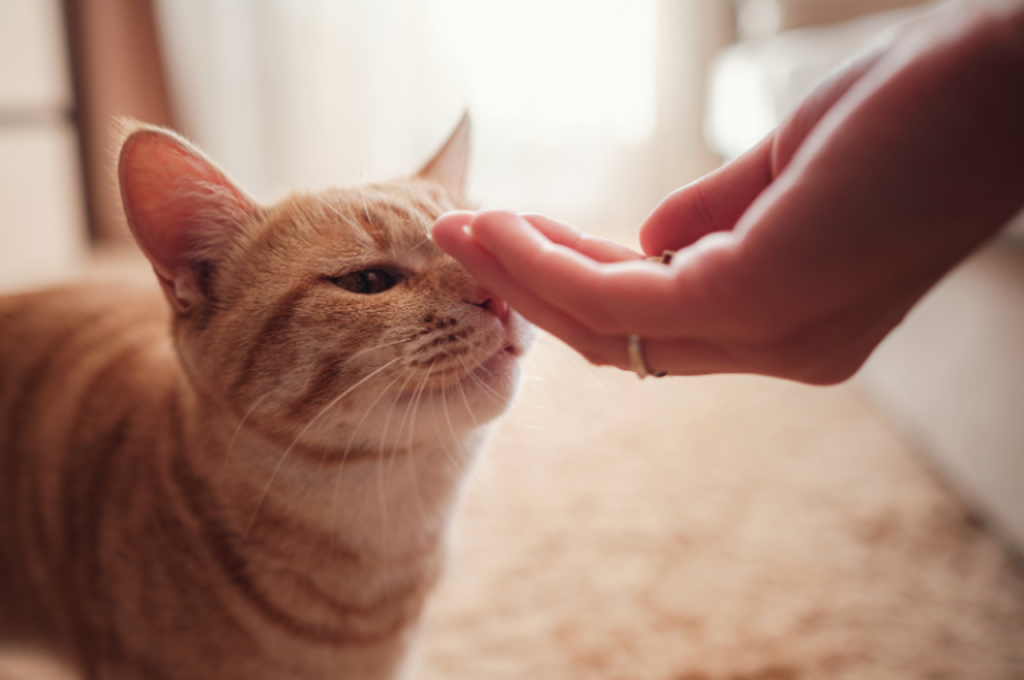Emotional support cat training involves teaching cats to provide comfort and companionship to individuals with emotional or mental health needs. During training, cats are taught to respond to cues and provide emotional support through various activities such as cuddling, sitting on laps, and purring.
Additionally, they can be trained to recognize and interrupt anxiety or panic attacks, provide a calming presence, and offer unconditional love and affection. This type of training requires patience, consistency, and positive reinforcement techniques to ensure the cat is comfortable and able to fulfill its role as an emotional support animal effectively.
It is essential to work with a professional trainer who specializes in cat training and understands the unique needs of emotional support animals.
The Significance of Emotional Support Cats
Effective emotional support cat training is essential for ensuring they offer consistent support to their owners. Training focuses on fostering a calm demeanor and reliable behavior, enhancing the emotional well-being of those they assist.

Benefits of Emotional Support Cats
Emotional support cats have a profound impact on individuals struggling with mental health issues. These feline companions provide a variety of benefits that contribute to the overall well-being of their owners.
Reduced Stress: An emotional support cat can significantly reduce stress levels, as spending time with these furry friends has been proven to lower blood pressure and heart rate. The soothing presence of a cat can help individuals relax and promote a sense of calmness.
Improved Mood: Interacting with emotional support cats can improve mood and decrease feelings of loneliness or depression. Their affectionate nature and companionship can bring a sense of joy and happiness to their owners.
Emotional Stability: Emotional support cats offer unconditional love and support, which can help individuals struggling with emotional instability. These feline companions provide a constant source of comfort and reassurance, helping their owners navigate through difficult emotions.
Enhanced Social Interaction: Owning an emotional support cat can encourage social interaction, as these animals make great icebreakers and can facilitate conversations with others. This can be particularly beneficial for individuals who find it challenging to connect with people.
Relief from Anxiety: Feeling anxious or having panic attacks can be incredibly distressing. Emotional support cats can offer a sense of security and help alleviate anxiety symptoms through their calming presence and the actions they perform.
Legal Rights of Emotional Support Animals
When it comes to emotional support animals, it’s essential to understand the legal rights granted to their owners. These rights are vital in ensuring individuals can access the support they need without discrimination.
Housing Rights: According to federal law, individuals with emotional support cats are protected under the Fair Housing Act. This act prevents landlords and housing providers from discriminating against tenants who require an emotional support animal.
Transportation Rights: Emotional support cats are also protected under the Air Carrier Access Act. This means that individuals with emotional support cats have the right to travel with their feline companions in the cabin of an aircraft, free of charge or additional fees.
Workplace Rights: Under the Americans with Disabilities Act, employers are required to make reasonable accommodations for employees with emotional support cats, as long as the animal does not pose a threat to the safety or health of others.
Educational Rights: Students with emotional support cats have the right to have these animals in their dormitories and on-campus housing, as long as they have appropriate documentation and meet the institution’s requirements.
Understanding Emotional Support Cat Training
Emotional support cats can provide comfort and companionship to individuals struggling with emotional or mental health issues. Understanding how to train these feline companions to offer the needed support is essential for fostering a strong bond and effective interaction between the cat and its owner.
Difference Between Service and Emotional Support Cats
Service cats and emotional support cats serve different roles. While service cats are trained to assist individuals with disabilities in tasks such as opening doors or retrieving objects, emotional support cats provide comfort and companionship to individuals with emotional or mental health challenges.
Importance of Training for Emotional Support Cats
Training for emotional support cats is crucial to ensure they can effectively provide comfort and support. Proper training helps them to recognize and respond to the emotional needs of their owner, fostering a loving and supportive relationship.
Selecting The Right Cat for Emotional Support
When it comes to selecting the right cat for emotional support, it is crucial to consider factors such as the breed’s temperament, personality traits, and individual needs.
Whether you are in need of an emotional support cat for anxiety relief, calming companionship, or simply unconditional love, choosing the right cat is a decision that requires careful consideration. Here are some key aspects to keep in mind when selecting the ideal cat for emotional support.
Choosing The Right Breed
Consider the different cat breeds and their inherent characteristics that best align with your emotional support needs. Certain breeds, such as Persians, Ragdolls, and Siamese cats, are known for their calm and affectionate nature, making them excellent choices for emotional support. These breeds are often gentle, sociable, and sensitive to their owners’ emotions, providing comfort and companionship in times of need.
Temperament Considerations
When selecting an emotional support cat, it’s essential to prioritize temperament over physical appearance. Look for cats with affectionate, gentle, and caring temperaments to ensure they can provide the emotional support you require. They should be comforting, calm, and empathetic, able to intuitively sense and respond to your emotional state. Observe their behavior during interactions to gauge their suitability for the role of an emotional support cat.
Building A Strong Bond
Building a strong bond with your emotional support cat is essential for a harmonious and fulfilling relationship. By focusing on creating a safe environment, establishing trust and connection, you can lay the foundation for a lifelong partnership with your feline companion. In this article, we’ll explore these key aspects of emotional support cat training in detail.

Creating A Safe Environment
A safe environment is crucial for your cat to feel secure and comfortable. Providing a dedicated space for your emotional support cat can help create this safe haven. Allocate a quiet corner or a cozy room where your cat can retreat to when they need some alone time. Furnish this space with a comfortable bed, toys, and scratching posts to cater to their natural instincts.
Additionally, ensure your home is free from potential hazards that could cause stress or harm to your cat. Keep toxic plants, cleaning supplies, and small objects out of reach. Minimize loud noises, such as appliances or loud music, as they can startle and stress your feline friend. A calm and serene environment will give your cat the security they need to build a strong bond with you.
Establishing Trust and Connection
Trust is essential in any relationship, and it is no different when it comes to your emotional support cat. Establishing trust takes time, patience, and consistency. Begin by respecting your cat’s boundaries and allowing them to approach you on their terms. Avoid forcing physical contact or overwhelming them with too much attention.
Creating positive associations with you is key to building trust. Use treats, praises, and gentle pats to reinforce positive behavior and interactions. Regular play sessions with interactive toys can also help to strengthen the bond. Spend quality time with your cat daily, engaging in activities they enjoy, such as grooming or playing.
In addition to trust, a strong connection is vital. Cats communicate through body language, and understanding their cues can help you build a deeper connection. Observe your cat’s facial expressions, tail posture, and ear movements to better understand their emotions. Responding appropriately to their needs and desires will enhance the bond between you and your emotional support cat.
Mastering Power Words for Emotional Support
Emotional support cats play a vital role in providing comfort and companionship to individuals dealing with various mental health challenges. Mastering power words for emotional support can significantly enhance the bond between you and your furry friend, making training sessions more effective.
Positive Reinforcement Techniques
Using positive reinforcement techniques such as treats and praise, you can motivate your emotional support cat to exhibit desired behaviors.
Understanding Cat Communication Cues
Studying your cat’s body language and vocalizations is crucial in understanding their emotions and needs.
Handling Behavioral Issues
Train your emotional support cat to handle behavioral issues effectively. Utilize positive reinforcement and patience to guide your cat towards desired behavior. Consistent training methods will foster a strong bond and mutual understanding between you and your support cat.
Identifying Stress Triggers
One of the key aspects of emotional support cat training is identifying stress triggers that can lead to behavioral issues. Cats, like humans, can experience stress, which can manifest in various ways. By recognizing these triggers, you can create a calm and supportive environment for your cat, minimizing their stress levels.
Some common stress triggers for cats include:
- Loud noises such as thunderstorms or fireworks
- Changes in routine or environment
- Introduction of new pets or people
- Medical issues or pain
- Lack of mental or physical stimulation
To identify stress triggers in your cat, observe their behavior closely. Look out for signs like excessive grooming, hiding, loss of appetite, or excessive meowing. It’s important to address these triggers to prevent the development of more serious behavioral issues.
Managing Aggression or Anxiety
Aggression and anxiety are common behavioral problems that emotional support cats may exhibit. It’s important to address them to create a harmonious relationship with your feline friend. By following these strategies, you can help manage these issues:
- Create a safe space: Provide a designated area where your cat can retreat to when feeling anxious or overwhelmed. Fill it with familiar and comforting items like their favorite bed or toys.
- Positive reinforcement: Use treats, praise, and playtime as positive reinforcements for good behavior. This will help your cat associate positive experiences with certain situations.
- Enrich the environment: Provide interactive toys, scratching posts, and vertical spaces for your cat to explore. This will help alleviate boredom and provide mental stimulation, reducing anxiety and aggressive behaviors.
- Consult a professional: If your cat’s aggression or anxiety persists, it’s essential to seek guidance from a professional animal behaviorist or veterinarian who specializes in feline behavior.
- Consider alternative therapies: In some cases, alternative therapies such as pheromone diffusers or calming supplements can help reduce anxiety in cats. Consult with your veterinarian to explore these options.
Remember, every cat is unique, and what works for one may not work for another. Patience, consistency, and understanding are key when handling behavioral issues in emotional support cats. By identifying stress triggers and implementing appropriate management techniques, you can create a peaceful and supportive environment for your feline companion.
Incorporating Routine and Consistency
Effective emotional support cat training ensures they offer consistent support to their owners. Consistency and routine are essential when training your emotional support cat. Regular training sessions help establish and reinforce desired behaviors, creating a dependable and soothing presence. By maintaining a consistent schedule, cats learn to adapt to their roles more effectively, enhancing the emotional well-being of those they assist.
Benefits of Consistent Training
- Reduces anxiety: Predictability creates a calm environment for your cat.
- Strengthens bond: Regular training sessions build trust between you and your cat.
- Improves behavior: Establishing a routine helps modify unwanted behaviors.
Establishing A Training Schedule
Creating a consistent schedule is key to successful emotional support cat training.
- Pick specific times: Choose times for training that fit your daily routine.
- Be patient: Training requires time, so stay dedicated to the schedule.
- Use positive reinforcement: Reward good behavior consistently to reinforce training.
Seeking Professional Guidance
When it comes to training an emotional support cat, seeking professional guidance can be a valuable step in ensuring the success of your training efforts. Consulting with a cat behavior specialist or enrolling in training classes can provide you with the expertise and resources needed to address your cat’s emotional support needs effectively.
Consulting with a Cat Behavior Specialist
Seeking guidance from a cat behavior specialist can be beneficial if you are experiencing challenges in training your emotional support cat. These professionals have in-depth knowledge of feline behavior and can provide personalized strategies to address your cat’s emotional support requirements.

When consulting with a cat behavior specialist, they can assess your cat’s behavior, identify potential triggers, and recommend targeted training techniques to foster a positive environment for both you and your cat.
Enrolling In Training Classes
For a more structured approach to training, enrolling your emotional support cat in training classes can be an effective option. Look for classes specifically tailored to emotional support animals, as they often integrate socialization, obedience, and emotional support training. These classes provide a supportive environment for both you and your cat, and the group setting can be beneficial for your cat’s socialization needs.
Conclusion
Proper training is key to ensure that your emotional support cat can provide the comfort and companionship you need. By following these essential tips and techniques, you can establish a strong bond with your feline friend and create a calm and supportive environment.
Remember to be patient, consistent, and reward their positive behavior. With dedication and love, your emotional support cat will become a valuable source of emotional stability in your life.
